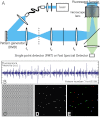Compressive fluorescence microscopy for biological and hyperspectral imaging
- PMID: 22689950
- PMCID: PMC3387031
- DOI: 10.1073/pnas.1119511109
Compressive fluorescence microscopy for biological and hyperspectral imaging
Abstract
The mathematical theory of compressed sensing (CS) asserts that one can acquire signals from measurements whose rate is much lower than the total bandwidth. Whereas the CS theory is now well developed, challenges concerning hardware implementations of CS-based acquisition devices--especially in optics--have only started being addressed. This paper presents an implementation of compressive sensing in fluorescence microscopy and its applications to biomedical imaging. Our CS microscope combines a dynamic structured wide-field illumination and a fast and sensitive single-point fluorescence detection to enable reconstructions of images of fluorescent beads, cells, and tissues with undersampling ratios (between the number of pixels and number of measurements) up to 32. We further demonstrate a hyperspectral mode and record images with 128 spectral channels and undersampling ratios up to 64, illustrating the potential benefits of CS acquisition for higher-dimensional signals, which typically exhibits extreme redundancy. Altogether, our results emphasize the interest of CS schemes for acquisition at a significantly reduced rate and point to some remaining challenges for CS fluorescence microscopy.
Conflict of interest statement
The authors declare no conflict of interest.
Figures





References
-
- Mertz J. Introduction to Optical Microscopy. Greenwood Village, CO: Roberts and Company Publishers; 2010.
-
- Brady DJ. Optical Imaging and Spectroscopy. Hoboken, NJ: Wiley; 2010.
-
- Donoho DL. Compressed sensing. IEEE T Inform Theory. 2006;52:1289–1306.
-
- Candes E, Romberg J, Tao T. Robust uncertainty principles: exact signal reconstruction from highly incomplete frequency information. IEEE T Inform Theory. 2006;52:489–509.
-
- Lustig M, Donoho D, Pauly P. Sparse MRI: the application of compressed sensing for rapid MR imaging. Magn Reson Med. 2007;58:1182–1195. - PubMed
Publication types
MeSH terms
LinkOut - more resources
Full Text Sources
Other Literature Sources

